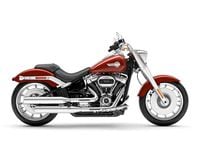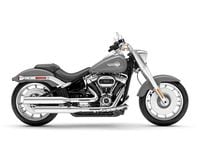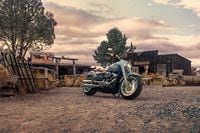Since its introduction in 1990, the Harley-Davidson Fat Boy has been a pillar of The Motor Company’s cruiser lineup—maybe somewhat surprisingly given an easy-to-mock name like Fat Boy. But what’s behind its staying power? As CW said in its review of the original Fat Boy back in January of 1990: “What’s different is the Fat Boy’s monochromatic paint and beefier styling, making it seemingly more solid than any other machine in the H-D lineup.” The Fat Boy’s sweeping handlebars, wide aluminum-dish wheels, and, ahem, “husky” proportions have persisted through three-plus decades of development.
The latest-generation model, introduced in 2018 was available with 107ci or 114ci Milwaukee-Eight engines until 2020, when the full-fat M-8 114 engine became the only option. The M-8 114 is, amazingly, the smallest-capacity Big Twin currently in the lineup (other than the M-8 107 used in the Softail Standard), and produces a claimed 94 hp at 4,750 rpm and 119 lb.-ft. of torque at 3,000 rpm. So even though the Fat Boy doesn’t use the 117ci engine like other models in the cruiser lineup (e.g., Breakout 117, Low Rider S, Low Rider ST), it hardly feels like a blight on its copybook. While it’s an intentionally bare-bones motorcycle, ABS and cruise control come standard. To quote David Edwards’ parting thoughts from 1990: “But it still has a silly name.” In the long run, it doesn’t seem like that’s hurt it.
The 2024 Fat Boy 114 in Billiard Gray for $21,999. Opting for Vivid Black adds $350; Red Rock, $525; or Sharkskin Blue, $650.
- Indian Chief, $14,999
- Harley-Davidson Breakout 117, $22,499










/cloudfront-us-east-1.images.arcpublishing.com/octane/5GDLAHSFVBBDHFMUYNDCJRWIGY.jpg)





/cloudfront-us-east-1.images.arcpublishing.com/octane/S35YGSEMEZB4BLTDJTSZPF4GLA.jpg)
/cloudfront-us-east-1.images.arcpublishing.com/octane/5UOT6HPX2JFMRJAX6EH45AR4MQ.jpg)
/cloudfront-us-east-1.images.arcpublishing.com/octane/OKWOJWAKP5EP3OACCRRWPCIX2Q.jpg)
/cloudfront-us-east-1.images.arcpublishing.com/octane/2WF3SCE3NFBQXLDNJM7KMXA45E.jpg)
/cloudfront-us-east-1.images.arcpublishing.com/octane/G4MG6OUCJNBSHIS2MVVOTPX65E.jpg)
/cloudfront-us-east-1.images.arcpublishing.com/octane/IIGGWFOTOJGB7DB6DGBXCCMTDY.jpg)
/cloudfront-us-east-1.images.arcpublishing.com/octane/QSTCM6AVEZA5JJBUXNIQ3DSOF4.jpg)
/cloudfront-us-east-1.images.arcpublishing.com/octane/U4I7G625B5DMLF2DVIJDFZVV6M.jpg)
/cloudfront-us-east-1.images.arcpublishing.com/octane/B6XD6LS6IVCQPIU6HXDJSM3FHY.jpg)
/cloudfront-us-east-1.images.arcpublishing.com/octane/ICL63FEDDRDTTMINYICCEYGMDA.jpg)
/cloudfront-us-east-1.images.arcpublishing.com/octane/FCGZHQXRBZFLBAPC5SDIQLVF4I.jpg)
/cloudfront-us-east-1.images.arcpublishing.com/octane/WNOB6LDOIFFHJKPSVIWDYUGOPM.jpg)

/cloudfront-us-east-1.images.arcpublishing.com/octane/X33NU3E525ECRHXLNUJN2FTRKI.jpg)
/cloudfront-us-east-1.images.arcpublishing.com/octane/6KKT5NNL2JAVBOXMZYS5ZO76YA.jpg)
/cloudfront-us-east-1.images.arcpublishing.com/octane/J5RKG5O455GMPGQRF2OG6LRT7A.jpg)
/cloudfront-us-east-1.images.arcpublishing.com/octane/GX2CIZKQVRH2TATDM26KFG2DAE.jpg)
/cloudfront-us-east-1.images.arcpublishing.com/octane/ZWIDYSAKQZHD5BHREMQILXJCGM.jpg)
/cloudfront-us-east-1.images.arcpublishing.com/octane/CYUHJZCTSJCH3MRAQEIKXK7SCQ.jpg)
/cloudfront-us-east-1.images.arcpublishing.com/octane/LKOFINY56FCXJCANJ5M7ZDQUBY.jpg)
/cloudfront-us-east-1.images.arcpublishing.com/octane/4NBPDACMWJH63JQYJVK3QRBDZI.jpg)
/cloudfront-us-east-1.images.arcpublishing.com/octane/KKHQHRR3FJGX7H2IPU6RALMWG4.jpg)

/cloudfront-us-east-1.images.arcpublishing.com/octane/5IOFS5JAE5FOXMNA23ZRAVVYUU.jpg)